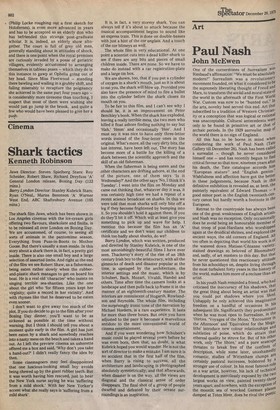Art
Paul Nash
John McEwen
One of the cornerstones of Surrealism was Rimbaud's affirmation: "We must be absolutely modern!" Surrealism was a revolutionarY movement founded, on what it considered to be the supremely liberating thought of Freud and Marx, to transform the social and moral state or the world in the aftermath of the First World War. Custom was now to be "hunted out." In the arts, novelty best served this end. Art that subscribed to a tradition of Western Christianity or a conception that was logical or rational was unacceptable. Cultural antecedents were, only to be found in primitive art or that or archaic periods. In the 1929 surrealist map of the world there is no sign of England. All this has, to be borne in mind when considering the work of Paul Nash (Tate Gallery till December 28). Nash has been called a surrealist — though he never considered himself one — and has recently begun to find critical favour so that now, nineteen years after his death, the Tate catalogue accords hU "European stature" and "English genius. Wishfulness and affection have got the better in these judgements, because Nash in this definitive exhibition is revealed as, at best, the painterly equivalent of Edward Thomas — 8 good minor poet in the English twentieth-century canon but hardly worth a footnote in the European. Retreat to the countryside has always been one of the great weaknesses of English artists, and Nash was no exception. Only occasional does he avoid being an honourable member of that troop of post-Hardians who worshipped again at the druidical shrines, and explored the ancient ways, the old corners of England. All too often in depicting that world his work is of the watered down Matisse/Cezanne varietY: stained drawings so beloved of BloomsburY and, sadly, of art masters to this day. But that he never questioned this reactionary attitude from his schooldays on, despite living through' the most turbulent forty years in the history of the world, makes him more of a recluse than an artist. In his youth Nash reminded a friend, who had criticised the inaccuracy of his shadows, that the great thing about being an artist was that you could put shadows where You liked' Unhappily he only achieved this imaginative freedom on a handful of occasions in his subsequent life. Significantly they predominate when he was most open to Surrealism, in the 'thirties. 'Voyages of the Moon,' Encounter in the Afternoon' and 'Equivalent for the Mega,: liths' introduce new colour relationships a" subtleties of poise, which do attain that ethereal quality he strove for. But of his other work, only 'The Shore,' and a pure seascape threaten to break free of the confines of description, while some later, unashamedlY romantic, studies of Wittenham clumps are certainly pastoral successes, bolstered by a stronger use of colour. In his most famous role, as a war artist, however, his lack of technical development is mercilessly exposed by the two largest works on view, painted twenty-three, years apart; and nowhere, with the exception or the moonlit sea of wrecked German planes dumped at Totes Meer, does he rival the poetic
achievement of his soldier contemporaries.
All in all, therefore, this is a disappointing Show, in essence adding little to the vision of Blake and Palmer on view any day of the week in Gallery 10. But more important, by its failure It questions the historical relevance of nearly all the so-called modern art produced in this country between the Wars, most of which appears to derive from the same sentimental source far more than from the European modernism with which it has proudly claimed association. Ironically, those artists who felt they were opening the doors to Europe and signalling the end of Brangwynism, now appear to have introduced a no less insidiously insular nostalgia for an irretrievable pre-industrial Past. As a result — and the enshrinement of _Henry Moore's Stonehenge drawings at the V&A (till January 18) only confirms it — Wyndham Lewis's Blast is, sadly, as relevant today as it was sixty years ago.



































 Previous page
Previous page